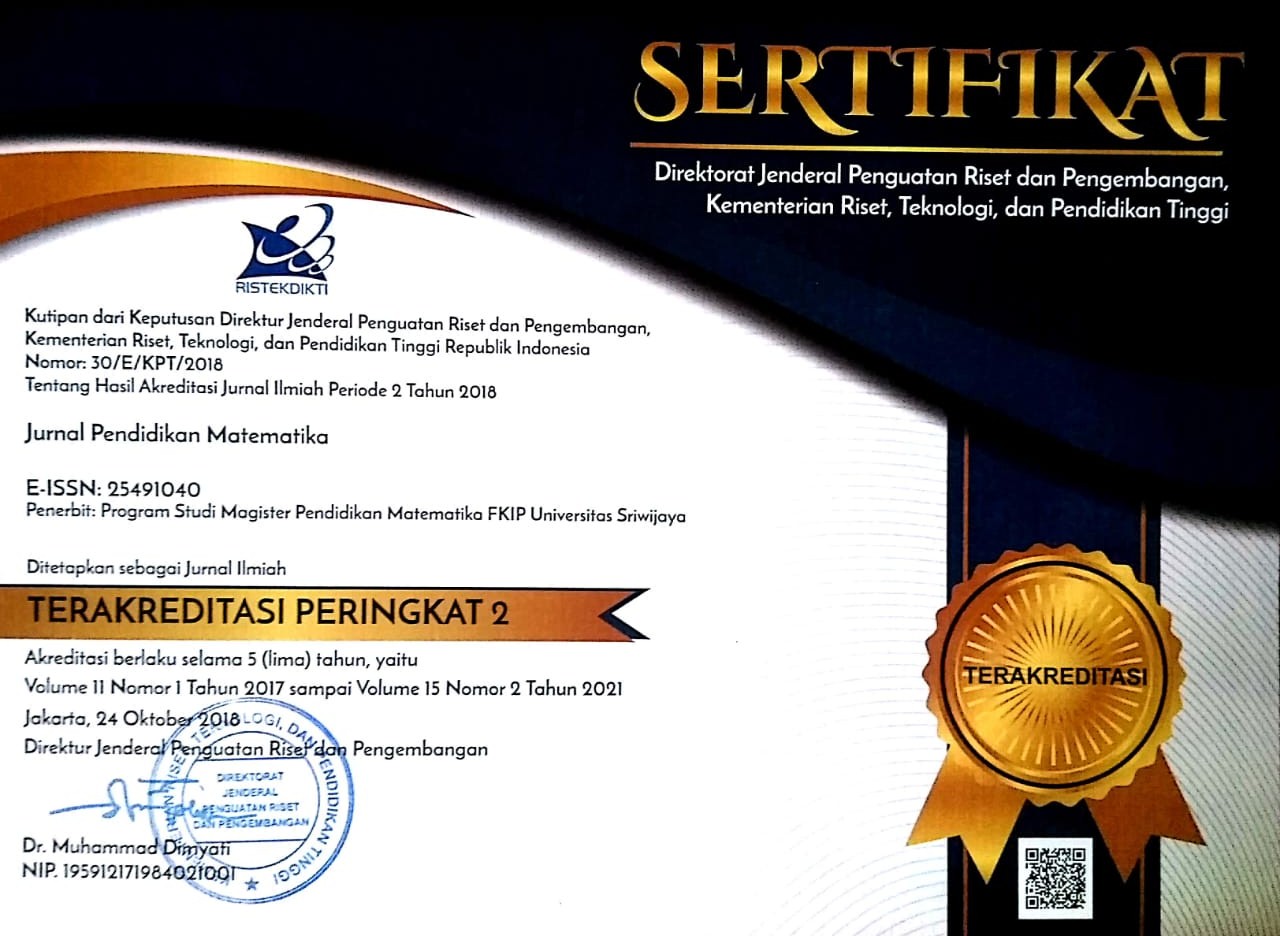Students' Mathematical Literacy in Solving PISA Problems Observed by Learning Styles
Abstract
Mathematical literacy helps an individual recognize the role or use of mathematics in everyday life. One of the factors supporting mathematical literacy is the learning style of the student. This study aimed to describe the mathematical literacy of students in the context of SMP Negeri 1 Palopo based on their answers to PISA test questions by observing their learning styles. The subjects in this study were three eighth graders each representing visual, auditory, and kinesthetic learning styles. The data instruments used were a learning style questionnaire, a mathematical literacy test based on the 2012 PISA test draft, and an interview guide. The results of the learning style questionnaire were analyzed by referring to the indicators of the three learning styles under study, while the results of the PISA test were analyzed by referring to the indicators for each PISA level. The results of this study indicated that the visual student and the auditory student had mathematical literacy at level 3 as shown by their ability to connect and reflect things involved in interpretation and basic reasoning, while the kinesthetic student had mathematical literacy at level 4 as shown by their ability to build and communicate explanations and argumentation based on interpretations, arguments, and actions. Based on the research results, it is suggested that students be accustomed to working on PISA-like problems to improve their mathematical literacy.
Keywords
Full Text:
PDFReferences
De Lange, J. (2003). Mathematics for Literacy. In Quantitative Literacy: Why Numeracy Matters for Schools and Colleges. National Academy of Sciences, 75–89. https://bit.ly/2JULZQx.
DePorter, B. & Hernacki, M. (2007). Quantum Learning: Familiarize Learning Comfortable and Fun (1st ed.) [in Bahasa]. Bandung: Kaifa Learning.
Fadillah, A. & Ni’mah. (2019). Analysis of students' mathematical literacy in solving PISA mathematics problems on change and relationship content [in Bahasa]. JTAM ( Jurnal Teori Dan Aplikasi Matematika), 3(2), 127–131. https://doi.org/https://doi.org/10.31764/jtam.v3i2.1035.
Hasanudin, C. & Fitrianigsih, A. (2019). Analysis of student learning styles in flipped classroom learning [in Bahasa]. Jurnal Pendidikan Edutama, 6(1). https://doi.org/10.30734/jpe.v6i1.364.
Heine, J. H. (2022). Evaluating the effects of analytical decisions in large-scale assessments: analyzing PISA mathematics 2003-2012. Large-Scale Assessments in Education, 10(1). https://doi.org/10.1186/s40536-022-00129-5.
Hertiandito, L. T. (2016a). Mathematics literacy skills of junior high school students in Knisley learning in terms of learning styles [in Bahasa]. PRISMA, Prosiding Seminar Nasional Matematika, 2011, 89–96.
Hidayah, A. R., Hakiki, I. A., Afwi, M. F., & Fiangga, S. (2020). Secondary school students' mathematical literacy ability in solving pisa problems in view of visual learning styles [In Bahasa]. 7(2), 6–13. https://doi.org/10.26714/jkpm.7.2.2020.6-13.
Imam, F., Zaenuri, Z., & Nugroho, S. E. (2020). Mathematical literacy ability in learning problem-based learning with ethnomatic mathematics based on student learning styles. Unnes Journal of Mathematics Education Research, 9(2), 131–138. https://journal.unnes.ac.id/sju/index.php/ujmer/article/view/32821.
Isnanto, I. (2022). Student learning outcomes viewed from learning styles [in Bahasa]. Aksara: Jurnal Ilmu Pendidikan Nonformal, 8(1), 547. https://doi.org/10.37905/aksara.8.1.547-562.2022.
Lehmann, T. & Ifenthaler, D. (2012). Influence of students’ learning styles on the effectiveness of instructional interventions. Proceeding of International Conference on Cognition and Exploratory Learning in Digital Age (CELDA) 2012. Madrid, Spain: IADIS. https://iadisportal.org/celda-2012-proceedings
Lestari, N. & Putri, R. I. I. (2020). Using the Palembang’s local context in PISA-like mathematics problem for analyze mathematics literacy ability of students. Jurnal Pendidikan Matematika, 14(2), 169–182. https://doi.org/10.22342/jpm.14.2.6708.169-182.
Machromah, I. U., Sutama, S., Prayitno, H. J., Faiziyah, N., & Fatmasari, L. W. S. (2020). Designing PISA-like mathematics task to assess students’ mathematical literacy. Universal Journal of Educational Research, 8(10), 4986–4995. https://doi.org/10.13189/ujer.2020.081072.
Masjaya & Wardono. (2018). The importance of mathematical literacy ability to grow mathematical connection ability in increasing human resources [in Bahasa]. Prosiding Seminar Nasional Matematika UNNES 2017, 568–574, Semarang: UNNES.
Nizar, H. (2018). PISA-like mathematics problem with karate context in Asian Games. Journal of Physics: Conference Series, 1088(1), 012063. https://doi.org/10.1088/1742-6596/1088/1/012063.
OECD. (2015). PISA 2015 Draft Mathematics Framework. OECD Publishing.
OECD. (2019). Indonesia – Country Note – PISA 2018 results. Retrieved from https://www.oecd.org/pisa/publications/PISA2018_CN_IDN.pdf.
Oktaviyanthi, R. & Agus, R. N. (2019). Exploration of problem solving ability based on mathematical literacy process category [in Bahasa]. Jurnal Pendidikan Matematika, 13(2), 163–184. https://doi.org/10.22342/jpm.13.2.7066.163-184.
Pratiwi, G., Sova, F., Putra, F. G., Yunian, P. R. W., Kusuma, A. P., & Rahmawati, N. K. (2020). The influence of project-based learning (PjBL) and learning style on mathematics communication skills of junior high school students. Journal of Physics: Conference Series, 1467(1), 012064. https://doi.org/10.1088/1742-6596/1467/1/012064.
Selan, M., Daniel, F., & Babys, U. (2020). Analysis of students' mathematical literacy skills in solving PISA questions on change and relationship content [in Bahasa]. AKSIOMA : Jurnal Matematika Dan Pendidikan Matematika, 11(2), 335–344. https://doi.org/10.26877/aks.v11i2.6256.
Soleh, R. M., & Yanti, N. (2019). The influence of visual, auditorial and kinesthetic learning styles on the students' achievement of Secondary School Dian Andalas Padang [in Bahasa]. JRPP, 2(2). https://doi.org/10.31004/jrpp.v2i2.486.
Stacey, K. & Turner, R. (2015). The Evolution and Key Concepts of the PISA Mathematics Frameworks. In: Stacey, K., Turner, R. (eds) Assessing Mathematical Literacy. Springer, Cham. https://doi.org/10.1007/978-3-319-10121-7_1
Supriyomo, W. & Ahmadi, H. A. (2004). Learning Psychology (Revised Eds.) [in Bahasa]. PT. Rineka Cipta.
Widayanti, F. D. (2013). The importance of knowing student learning styles in classroom learning activities [in Bahasa]. Erudio Journal of Educational Innovation, 2(1). https://doi.org/10.18551/erudio.2-1.2
DOI: https://doi.org/10.22342/jpm.17.1.19905.121-134
Jl. Srijaya Negara, Bukit Besar
Palembang - 30139 Indonesia
Jurnal Pendidikan Matematika is licensed under a Creative Commons Attribution-NonCommercial-ShareAlike 4.0 International License.
Indexed in:


